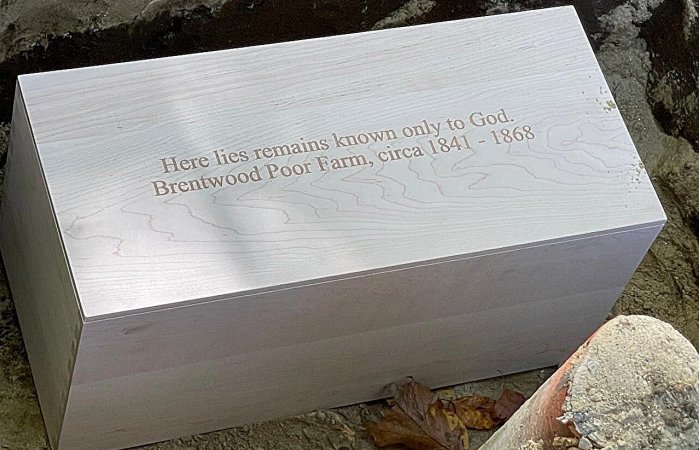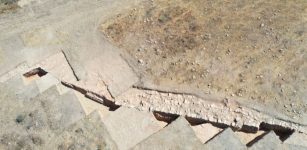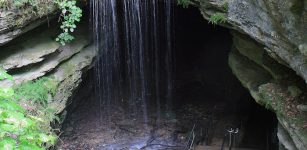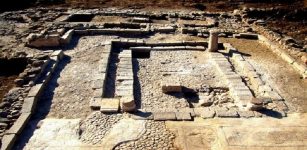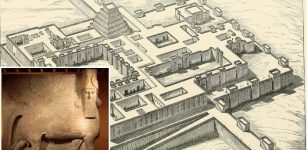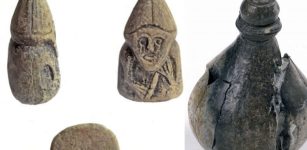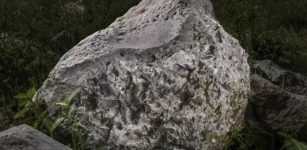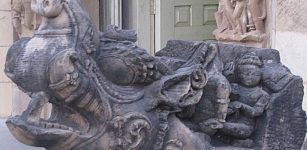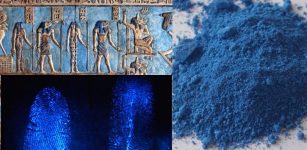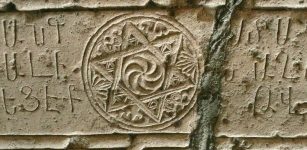Why Were These People Buried In A Remote, Unmarked Grave In New Hampshire In The Mid-1800s?
Jan Bartek - AncientPages.com - On a bright autumn afternoon, a plain wooden box made by a local cabinet shop, containing skeletal remains, was returned to its final resting place in Brentwood during a straightforward reburial ceremony.
For two years, researchers and students from the University of New Hampshire's Forensic Anthropology Identification and Recovery (F.A.I.R.) Lab collaborated with town officials and the New Hampshire state archaeologist to investigate and document these remains.
The remains from the poor house were buried in a simple worrdne box crafted by a local cabinet shop that was inscribed with "Here lies remains only known to God, Brentwood Poor Farm, circa 1841–1968." Credit: Robbin Ray / UNH
Originally uncovered over 20 years ago during construction, the remains were identified as belonging to a mid-1800s farm for paupers, commonly referred to as a poor farm.
"We analyzed the skeletal remains to determine their age and condition and help solve the mystery of why they were buried in the remote area in an unmarked grave," said Alex Garcia-Putnam, co-director of UNH's F.A.I.R. Lab.
"After several years of documenting the skeletal remains, we were honored to not only provide valuable information about their lives, but to also have the rare opportunity to be present at the reburial—to put these individuals at peace and offer all interested parties some sense of closure."
Historical Research And Skeletal Analysis
The New Hampshire state archaeologist examined these remains and identified them as historic based on their age and condition. They were then stored at the New Hampshire medical examiner's office for 23 years. In 2022, the remains were moved to the University of New Hampshire (UNH), where researchers began a detailed skeletal analysis.
The F.A.I.R. Lab at UNH collaborates with law enforcement and the state's medical examiner's office to aid in identifying human remains. In this particular case, their work focused on historical research. The team analyzed the bones to establish their age and assess the health conditions of those individuals, while also examining town records and maps to understand more about the historical context of where these remains were found.
The skeletal analysis revealed signs of hardship such as poverty and hard labor, along with health issues like osteoarthritis, dental disease, and other physiological stresses. These remains were initially discovered in an unmarked grave—further evidence of poverty—on land believed to have been part of Brentwood Poor Farm from 1841 to 1868.
Poor farms functioned as welfare institutions in rural U.S. counties during the 19th and early 20th centuries, providing shelter in exchange for labor but often subjecting residents to exploitative treatment. These farms aimed to keep marginalized groups—including those affected by poverty, race, ethnicity, or mental/physical illness—away from middle- and upper-class society's view.
These People Deserve A Respectful Burial
The town of Brentwood collaborated with the current landowners to arrange a reinterment at the exact site of the original grave. Historically, paupers at the farm were likely interred in quickly prepared, unmarked graves. Over time, these burial sites were forgotten as the poor farm model for social welfare was phased out during the 1930s and 1940s, and subsequently, the land transitioned into private ownership.
"All individuals deserve a respectful final burial and we hope that this event shows that Brentwood cares about its residents," said Joyce Keegal, superintendent of cemeteries in Brentwood. "We are so thankful for the work done by UNH to not only help shed light on the lives of these individuals but to also help us advocate for them."
"This has been an amazing community collaboration by the town of Brentwood, the state, the homeowners and UNH to not only provide answers and connect the threads but also bring closure and meaningful resolutions for all involved," said Amy Michael, co-director of UNH's F.A.I.R. lab. "We work on all kinds of investigations—criminal to cold cases—and it is so fulfilling to move someone from a shelf in a medical examiner's office humanizing them by giving them a dignified burial. Today was a good day."
The burial site is on private property in an undisclosed area. Plans are in place by Brentwood town officials and historical society for a future exhibit about the Brentwood Poor Farm.
The study was published in the journal American Antiquity
Written by Jan Bartek - AncientPages.com Staff Writer

